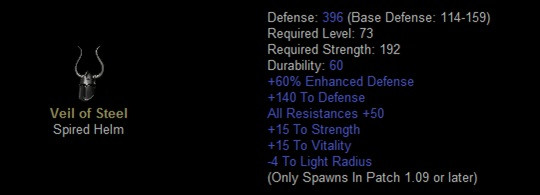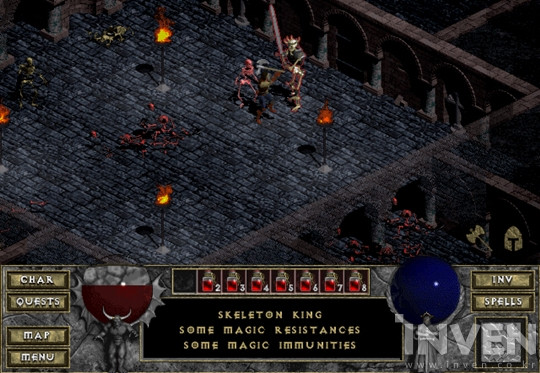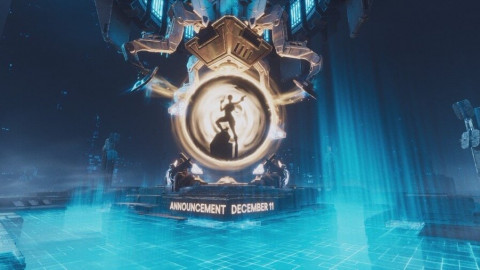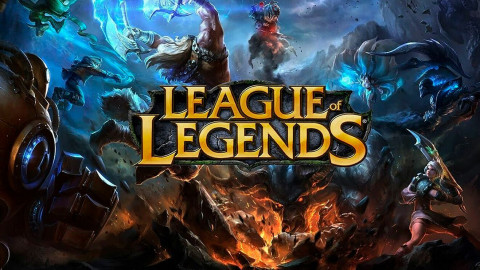Hello, Nephalem! This time, we are going to take a look at the world of Sanctuary. It all began with the launch of the first Diablo in 1997.
Diablo I was quite a simple game, where you delve down into the dungeon under the Tristram Cathedral to defeat the Prime Evil, Diablo. There were no multiple fields, and there were no interruptions to the story. You just had to keep going deeper into the dungeon. In Diablo II however, there were diverse map compositions and fleshed-out stories; though different, these additions were well-received by players.
A major improvement was made later on in Diablo III. Blizzard brought clarity to the story of Sanctuary and the Nephalem, as well as to the general storyline of Diablo. As a result, the world of Diablo became more realistic, though some players have criticized that Blizzard went too far with the storyline.
So, where did the Diablo story come from? When did the concept of the Nephalem first appear? Let's take a look back and find out!
Diablo I: Did Blizzard consider a sequel?
Launched in 1997, Diablo I captivated a lot of players with its terrifying ambiance. I can still vividly remember the Butcher’s horrifying lines even now. However, most players focused on farming items and enjoying the tension of the game rather than focusing on its story. I recall Diablo I had no remarkable plot points besides the twist ending at the end.
But after I played Diablo II, the story of Diablo I looked totally different. I found out that two major clues of Diablo II’s story were already hidden in Diablo I. You could find them in the dialogue of the NPCs and in the ending narration.
※ Make sure you turn on the sound when you’re watching this video!
▲ “Ah..fresh meat!” The Butcher sure was a memorable moment of Diablo I
Let's start with the story of Diablo I for those who have not played the game. Everything started from the tragedy of Leoric, the King of Khanduras.
Fall of Leoric, the King of Khanduras
Leoric was originally an Eastern Lord, but in 1258 he received a request from the Archbishop Lazarus of the Zakarum Church. Upon Lazarus’ behest, Leoric settled in the small town of Tristram in the Khanduras region, which lay on the western coast of the continent, and soon became the King of Khanduras.

There was an old Horadrim Temple in Tristram, built over the labyrinth where Diablo’s Soulstone was hidden 200 years ago. Unaware of what lay beneath the ruins, Leoric rebuilt the temple and set up the Zakarum Cathedral. As time passed, Leoric began losing his mind, for Diablo had been unchained by Archbishop Lazarus and was slowly eating away at the king’s sanity.
After King Leoric lost his discernment, he fell victim to Lazarus’s cunning plan and ordered his most loyal Knight, Lachdanan, to invade the kingdom of Westmarch. Lachdanan knew that all of this was a plot by Lazarus, but since Lazarus had already secured authority, the Knight was forced to march towards the neighboring kingdom with Leoric’s first son, Aidan.
Shortly after the army left, the second Prince, Albrecht, who had remained in Tristram, disappeared. Enraged, King Leoric began to torture and execute countless people in his mad search for Prince Albrecht. But in fact, it was Archbishop Lazarus who kidnapped Albrecht. Though he had been driven mad, Leoric did not yield his soul to Diablo; thus, Lazarus turned his aim towards the frail Prince Albrecht, hoping he would be an easier target.

From the King of Khanduras to the Skeleton King
Meanwhile, Lachdanan, who had left for the western expedition, returned to Tristram with the few soldiers who survived the war. But only a mad King and a kingdom seized by terror were waiting for them. Lachdanan and his Knights, seeing the sorry state of their homeland, then decided to slay their mad King. When King Leoric died, he cursed Lachdanan and his Knights, saying "You will serve the King of Khanduras even after your death.”
Lachdanan had murdered the King, but he remained loyal and intended to place the body of King Leoric in the Royal Crypts. However, when he led the Knights down to the basement of the Cathedral, Diablo revived Leoric in the form of a huge skeleton. The resurrected Leoric, now the Skeleton King, began to slaughter the Knights in the crypt, and only Lachdanan was able to escape and make it to the end of the crypt.
Though Lachdanan avoided death, the curse of King Leoric began to corrupt his soul. He thought that he would harm his people if he went back to Tristram at this point, so he decided to go deeper underground and find a way to save himself.


Afterward, Leoric guarded the underground regions of the Cathedral in the form of the Skeleton King, until he was punished by Aidan, his first Prince.
When Lachdanan and his men did not return after venturing beneath the Cathedral, the people were disturbed. Then Archbishop Lazarus, who had not been exposed yet, appeared and organized a rescue team. He dragged them down beneath the Cathedral, saying that Prince Albrecht was caught by the devil in the basement of the Cathedral.
But we would never hear anything again from the rescue team. If you have played Diablo 1, you might be able to guess that they became a fresh dinner for the Butcher.
Leoric was slain by Aidan, his firstborn
Rumors began to spread about the devil that dwelled in the basement of Tristram Cathedral. Many adventurers descended the stairs to the underground, hoping to find the treasure or to test their courage, but none of them came back. One day, the first Prince Aidan (Warrior) returned to Tristram from the western expedition.
Aidan was told about his and his family's past and ventured down to the basement of the Cathedral with other adventurers, saying that he would kill the devil and save his brother Albrecht. But it was not the devil that came to meet Aidan under the Cathedral, it was his father Leoric, who was now a minion of Diablo known as the Skeleton King.
According to Cain's record, Aidan felt heartbroken upon seeing his father turned into the Skeleton King, but he did not back down. The Skeleton King was so powerful that he knocked out the Knights of Lachdanan with one swing, but the courage of Aidan and the adventurers was stronger than the ruined king.

The beginning of a tragic destiny - Aidan and Diablo
Aidan continued to descend deeper into the underground after defeating the Skeleton King. He managed to find and save Lachdanan, who was barely holding on to his humanity as he wandered through the labyrinth. Venturing further, Aidan found and defeated Archbishop Lazarus, who had been offering sacrifices to Diablo. Finally, Aidan arrived at Diablo’s lair, and with the help of the adventurers, succeeded in defeating Diablo.
However, what they defeated was nothing but Prince Albrecht trapped in the body of Diablo. As the Soulstone was removed from Albrecht’s head, his body returned to normal. Standing in front of the body of his dead brother, Aidan’s mind broke. On that day, no one knows why he made his next decision. He looked at the bloody Soulstone seated in his hand for a moment and then put it into his forehead without hesitation.
Some say that Aidan's decision stemmed from revenge or that he wanted to sacrifice himself to keep Diablo in his body forever. Some even say that this was part of Diablo’s plan all along.


Wait, something’s not right.
If you have played Diablo 1 yourself, then you might have noticed something strange about this story.You see, at the time of Diablo I, the character Aidan did not exist. The Warrior in Diablo I was later named Aidan in order to add more backstory to Diablo II’s Dark Wanderer. The whole story was enhanced again in Diablo III for the third Diablo, Leah.

The Warrior was a stranger to the Tristram villagers in the Diablo I. Even Lachdanan, the Knight leader who had left for the western expedition together with Aidan in the story, did not recognize him.
Lachdanan was cursed by King Leoric and was slowly losing his humanity as he wandered deeper underground. When they met, he asked the Warrior to find the Golden Elixir so that he may die as a human. It is not convincing that a person with such a clear mind could not have recognized the Prince.
※ There is a chance that you can find Lachdanan on the 14th basement floor if you play it in a single-player mode.
Not to mention when you defeat the Skeleton King with the Warrior, you only hear the Warrior say “Rest well Leoric. I’ll find your son.” Even in the battle against Archbishop Lazarus, who had sent Aidan and Lachdanan to the western expedition, you won’t find any event or dialogue that even hints at them knowing each other.
Also, if you killed Diablo as a Rogue or Sorcerer instead of the Warrior, you might remember that in the cutscene, your respective character appears instead of Aidan, and still puts the Soulstone in their forehead. This clearly shows that at the time, the Warrior was not a Prince, but just another adventurer.

Lut Gholein and Kurast were predicted
The story of Prince Aidan was not in the original scenario, but a large portion of Diablo II’s story was already foreshadowed in the first one. They showed a small clue at the end of Diablo I through the story of the Dark Wanderer.
Below is the ending cinematic for Diablo I. The epilogue begins at 1:45, and you are told from the narration that the Warrior will travel to the mysterious land on the east side of the Aranoch, while constantly fighting against the evil that lies inside the Soulstone.
Aranoch is the desert area where Lut Gholein is built. The site on the other side of the Aranoch is likely Kurast, which has the Temple of Zakarum. Diablo 2, which was released about three years after Diablo I, followed this narration exactly.

Source: Stimpackswe
Diablo I Epilogue Narration:
“The Soulstone burns with hellfire as an eerie red glow blurs your vision. Fresh blood flows into your eyes, and you begin to hear the tormented whispers of the damned. You have done what you knew must be done. The essence of diablo is contained for now. You pray that you have become strong enough to contain the demon and keep him at bay. Although you have been fortified by your quest, you can still feel him clawing his way up from the dark recesses of your soul. Fighting to retain control, your thoughts turn toward the ancient mystic lands of the far east. Perhaps there, beyond the desolate wastes of Aranoch, you will find an answer, or perhaps salvation.”
Unlike the first one, Diablo II (Original) has 4 Acts. Each act has a unique setting, such as plains, desert, jungle and even Hell. In Diablo II, you are to chase the three Prime Evils by following the legend of the Horadrim. This setting was already established in Diablo I.

Aside from a few exceptions, quests in Diablo I will appear in a random order, so you have to play five or more times to experience all the backstory. However, even if you only play it through once, you could still find some hints regarding the Horadrim. Of course, nobody would have known that the Horadrim would be a big part of the second Diablo series in 1997.
After you discover the Staff of Lazarus on the 15th floor of the basement and return to Deckard Cain in the village, he will tell you that he is the last descendant of the Horadrim. He then tells you that Lazarus has betrayed them and requests that you defeat Lazarus once and for all. Right before your confrontation with the youngest Prime Evil, Cain also mentions that Diablo was one of the Prime Evils that had been sealed away for eternity by the Horadrim.

When you play it repeatedly, you can read stories found in the underground dungeons that tell you about the Horadrim or the Sin War. The creation of the Horadrim, the Great Evil chase, and the reason why the Great Evils have been driven out of Hell and into Sanctuary. This part was also added into the Diablo chronology that was published in guidebooks when Diablo 2 was launched in Korea. Most of the concepts that I thought were created in Diablo II were already in the first one.
You can also get a glimpse of the devils of Hell named Belial and Azmodan, as well as some information about the eternal conflict of Heaven and Hell. However, the concept of the Nephalem seems to have not been established in the first installment of the series. In one of the Horadrim’s ancient books, "The Wages of Sin are War", the story of the mortals is told, but the word Nephalem was never found.


However, the outline of the Nephalem story, which is represented by Uldyssian, can be seen in Diablo I. Some of the narrations look similar to the Diablo novel "The Sin War" published in 2011.
▲ There are some random objectives in the dungeon that help you to learn more about the world of Diablo (Source: MrHazardzone)
If so, Diablo II is a tragic story
So far we have talked about the overall story of Diablo I, additional world-building, and what the ending narration suggests. If you wish to play Diablo I just to see the ending, it can be summed up as follows, "The Prince has disappeared so a hero ventures to rescue the Prince and they all suffer tragedy in the end." Though that isn’t an incorrect summary, I found that the story is much deeper than a simple tale of a hero rescuing a Prince.
Also, the lore and setting were not just a premise for the game, they could actually be seen and heard directly in Diablo I. Information about the world of Sanctuary was given as a reward for repeated playthroughs.
Next time, we will look at Diablo II, which is considered to be the beginning of Diablo's full-fledged history. Let's see what life is like for the Warrior who accepted the Soulstone that was once embedded in Albrecht, and what trials the heroes face as they chase after him.
See you in the next episode!
Sort by:
Comments :0







